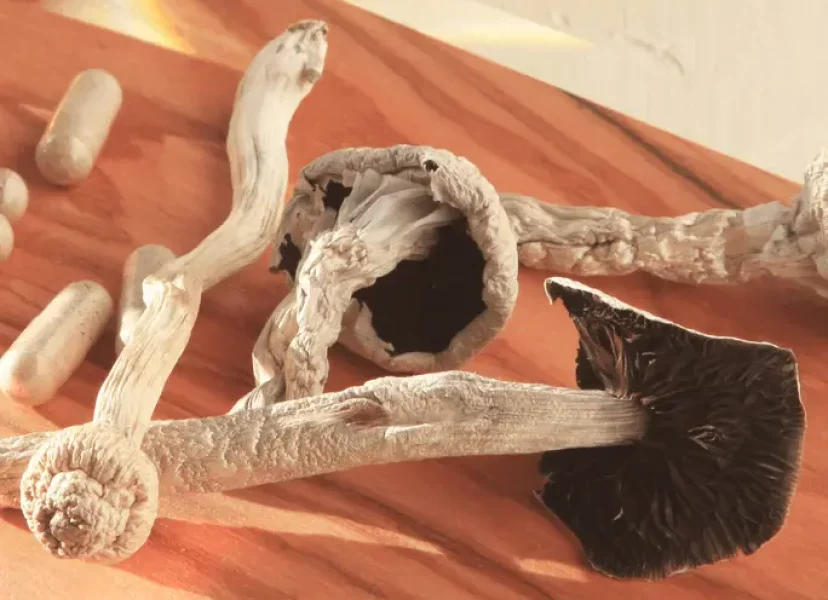Psychedelics have piqued a lot of people’s interest in recent years. Sure you may have heard LSD or ‘magic mushrooms’ being referenced in popular songs and movies, but you may be surprised to hear that doctors and patients across the country are increasingly interested in implementing psychedelic assisted therapy to help with a series of mental health conditions.
In some ways, this is unsurprising as the history between psychedelics and medicine is far richer than you would think. Different psychedelic substances have been used in spiritual healing ceremonies for hundreds of years by indigenous cultures across the world, most notably in South America. Western-medicine oriented research into psychedelics was prevalent as early as 1895.
Psychedelics generally carry a low risk of abuse or dependence; in fact, they’re shown to be substantially more powerful against addiction than most conventional treatments. Psychedelic substances, or entheogens, are also demonstrated to produce lasting benefits for many different mental health conditions, including depression, anxiety, PTSD, and others.
But what exactly is psychedelic assisted therapy? And how does it work in modern day? Here, we’ll discuss what psychedelic assisted therapy is, its potential benefits, the difference between conventional therapy methods, and what options may be available to you.
Defining Psychedelic Assisted Therapy
There are many different therapeutic practices for the mind and body, with some involving the use of psychedelics. We’ll work on making those distinctions later, but for now, let’s define therapy more broadly.
At its most basic, therapy is any treatment applied with the intention of treating or healing an ailment. Physical medicine, surgery, and rehabilitation are almost always therapeutic by nature.
Psychedelic assisted therapy is the actual use of the psychedelic substance by the patient under the administration and supervision of a professional. This type of therapy usually focuses on mental health issues or conditions the user is trying to manage or alleviate.
The use of psychedelics is often accompanied by other therapy models, such as talk therapy or psychodynamic therapy during the event. Psychedelic integration practices are also used before and after. Though there are several different modalities for psychedelic assisted therapy, for the purposes of this article, we’ll be focused on therapy that is overseen and administered by licensed medical professionals.
At Psychedelic Passage, we have a deep respect for shamanic healers and international retreats who focus on non-westernized healing modalities. Given the current regulatory status of many psychedelic substances, the only way for American patients to access these modalities locally is by working with a ceremonial trip sitter. The one caveat is that you will be responsible for sourcing your own psychedelic substance.
Because of this, ketamine assisted therapy and cannabis assisted therapy are currently the only legal options in the United States. Ketamine must be administered by a licensed medical professional whereas the laws regarding the use of cannabis in therapy are less stringent depending on the state you live in. With the current legislative and political trends, psychedelic assisted therapy using other substances may become legalized and available in the near future.
Benefits of Psychedelic Assisted Therapy
Compared to traditional talk therapy, prescription medication, and other mental health interventions, psychedelic therapy demonstrates compelling benefits. Existing studies show that psychedelic therapy yields long-term benefits for people seeking to treat many different conditions and symptoms.
For example, depressed patients in several different studies reported increased energy, improved mood, and even reduced physical pain after a single psychedelic therapy session. There are similar results for those suffering from PTSD and cPTSD. These effects lasted for months in most patients, and up to years for some.
The benefits were amplified with continued psychedelic assisted therapy, and were also noted in patients who microdosed with psychedelics (microdosing is taking small amounts of psychedelics to receive therapeutic benefit without eliciting a full-blown hallucinogenic experience).
Anxiety and compulsive behavior patients also noted relief from symptoms after psychedelic assisted therapy. These findings appear to support the notion that psychedelic therapy helps our neurons to regenerate and form new connections.
This is compelling news, as the prevailing understanding for most of medical history was that brain function could not be altered or repaired. Entheogens, it turns out, can literally rewire our brains for healing—something that was previously thought to be impossible!
This rewiring may also be helpful in breaking the cycle of addiction. Since addictive behavior is strongly rooted in our rewards centers, the ability of psychedelics to form new neural connections may be key to their efficacy.
And because psychedelic experiences often cause deep introspection and access to both conscious and subconscious parts of the mind, they may help one get to the root causes of their addiction. In one study, psychedelic therapy reduced the relapse rate of a group of alcoholics to 50% a year after therapy.
This may not sound very impressive, but the next-best intervention was 12-step therapy that has a 90% relapse rate. Comparatively, this makes psychedelics potentially the most successful way to treat many different types of addiction.
Granted, the nature of addiction makes it exceedingly difficult to treat, and even with psychedelic therapy, recovery may be a nonlinear journey. That said, the existing research demonstrates encouraging results.
What Makes Psychedelic Assisted Therapy Different?
Traditional methods to treat conditions like anxiety, depression and PTSD usually consist of anti-anxiety or antidepressant prescriptions that temporarily alleviate symptoms while patients undergo psychotherapy. It can take months or years before significant progress is made. All the while, some of these medications can have side effects that can deteriorate one’s quality of life including insomnia, constipation, fatigue, inability to focus, and increased suicidality in certain cases.
What’s more is that there is a percentage of the population that do not respond effectively to traditional methods, and have what is referred to as ‘treatment-resistant’ conditions. Because of this, psychedelic assisted therapy is emerging as an alternative treatment with increasing promise.
One key difference between psychedelic assisted therapy and more traditional methods is the use of psychedelic compounds to facilitate the experience, often in the presence of a licensed medical professional. Traditional methods have the patient taking medication every day to manage their symptoms, but the psychotherapy process is usually separate.
Another difference is the length of time each method takes. Some studies show that a single dose of psychedelics can create positive results that may take months or years with traditional therapies alone. Furthermore, some report that these benefits last well after the hallucinogenic event.
Perhaps the most important distinction is that conventional therapies address a patient’s symptoms first, then rely on psychotherapy to navigate the various blockages, defenses, and issues the mind has surrounded the specific mental ailment with.
Alternatively, psychedelic assisted therapy allows the user to focus on the root issues of our conditions first, and symptoms typically lessen or disappear altogether through this process.
This is because, in the most literal sense, entheogens open our minds to novel states of consciousness. These altered states are not accessible to us under ordinary circumstances, but psychedelics allow the user to safely access parts of the psyche, allowing our minds to address past traumatic events in new ways.
And if trauma isn’t the source of the mental condition, the rewiring of the brain mentioned previously allows our minds to process stimuli in new ways. This expanded perspective may facilitate improved processing, healing, and self-awareness in a way that other therapies cannot.
Types of Psychedelic Therapy Approaches
Psychedelic assisted therapy can be defined by the particular substance used as well as the specific psychotherapy methods applied. Though ketamine and cannabis assisted therapies are currently the only legal options in America, there is increasing evidence that psilocybin, MDMA, LSD, and even DMT may soon become available as viable treatment alternatives.
The specific psychotherapy modality will depend on the specific mental health condition of the user as well as context and issues discovered during the psychedelic event. For example, a patient seeking to alleviate their anxiety may have a different therapeutic method than an individual seeking to break an addiction.
Or someone may undergo therapy to address their depression, but discover a traumatic childhood event that is contributing to their condition, which would require an expert in trauma and PTSD. Some go for individual healing but realize they have codependence or relationship issues, which would be best addressed by an interpersonal therapy specialist.
Regardless of your reason for seeking psychedelic assisted therapy, it’s important to be careful when selecting a therapist or practitioner. Because psychedelic therapy involves being with your therapist in an altered state, it is important to choose a practitioner that you feel safe with and a clinic that has appropriate and effective medical oversight and monitoring practices.
Take care to read reviews, ask for references, and make visits ahead of time to meet the practitioner and clinic staff—your safety matters most. And as previously mentioned, legality varies depending on the substance. If it’s helpful, we’ve put together a guide on how to find psychedelic assisted therapy near you and how to choose a trusted therapist.
The Importance of Integration
While they may not be appropriate for everyone, psychedelic assisted therapies show promising benefits for a number of different conditions. Individuals seek out psychedelic assisted therapy for a number of reasons, and many do so after trying conventional therapies with less than favorable results.
The benefits of psychedelic assisted therapy tend to outlast those of more conventional therapeutic or pharmaceutical methods. While the reason for this is not yet fully understood, it appears that psychedelics improve neuroplasticity. In layman’s terms, this means that entheogens allow our brains to physically rewire their connections, accessing various parts of the psyche, allowing a user to process core issues healthily, which contributes to long term wellness.
But psychedelic assisted therapy is not a magic bullet, and the hallucinogenic experience alone won’t cure you. Long term and sustained benefits have a direct correlation to the integration practices used. Psychedelic integration is the processing and unpacking of the psychedelic event and related issues that arise so that the user can integrate these lessons to improve their everyday lives.
That’s one crucial part of what we do at Psychedelic Passage. The goal of our trip sitting program is to ensure that those who seek to heal with psychedelics have adequate support before, during and after the experience.
As a part of this process, our experienced facilitators can help you understand the meaning of the trip, and help you convert your experience into significant insights that can maximize your benefit and greatly improve your life. All the while reducing potential harm and increasing your safety.
If you think you would benefit from a trip sitting service like ours, we’d be honored to be a part of your journey. Start today by scheduling a call to connect with one of our guides.



